Leading Lines
How To Use Leading Lines In Your Photography
Composition is an incredibly powerful tool. Leading lines is one of the composition techniques you need to know.
It can be used to tell stories, lead the eye and create a sense of movement, all by simply selectively placing elements within the frame.

Composition is enormously complex and there are many rules and principles to be aware of. You may well have encountered the rule of thirds as this is where most people are introduced to composition. It’s a simple rule, and a good place to start.
The next step along the journey is understanding leading lines. Being able to spot leading lines within the frame will help you improve no end. I hope both students and teachers looking to teach leading lines in photography will both find this article useful, here we will aim to answer:
How do you find leading lines?
What types of leading lines are there?
Why are leading lines used?
If by the end of this article you’re still hungry for more, or if you’re a teacher looking for resources to hand out to students, Michael Freeman’s book The Photographers Eye is amongst the best I’ve seen for composition.
What are the leading lines in composition?
Leading lines are lines that lead!
The idea behind leading lines is to utilise strong lines within the scene to move the eye to a specific area or point in the frame.
This tool can be used to direct the viewer to a point of interest or to create a sense of movement.
It may seem like quite a simple principle, but there are a few factors that change how we view lines in an image.
The thickness, height, angle, shape, perspective, camera orientation and colour for example, can all affect how the eye interprets the line, and ultimately, whether to follow it or not. So whilst in it’s most simple form it may simple, as you may have already gathered, in photography, things can get complex quickly!

What are Leading Lines?
In the example image, leading lines, are these lines.
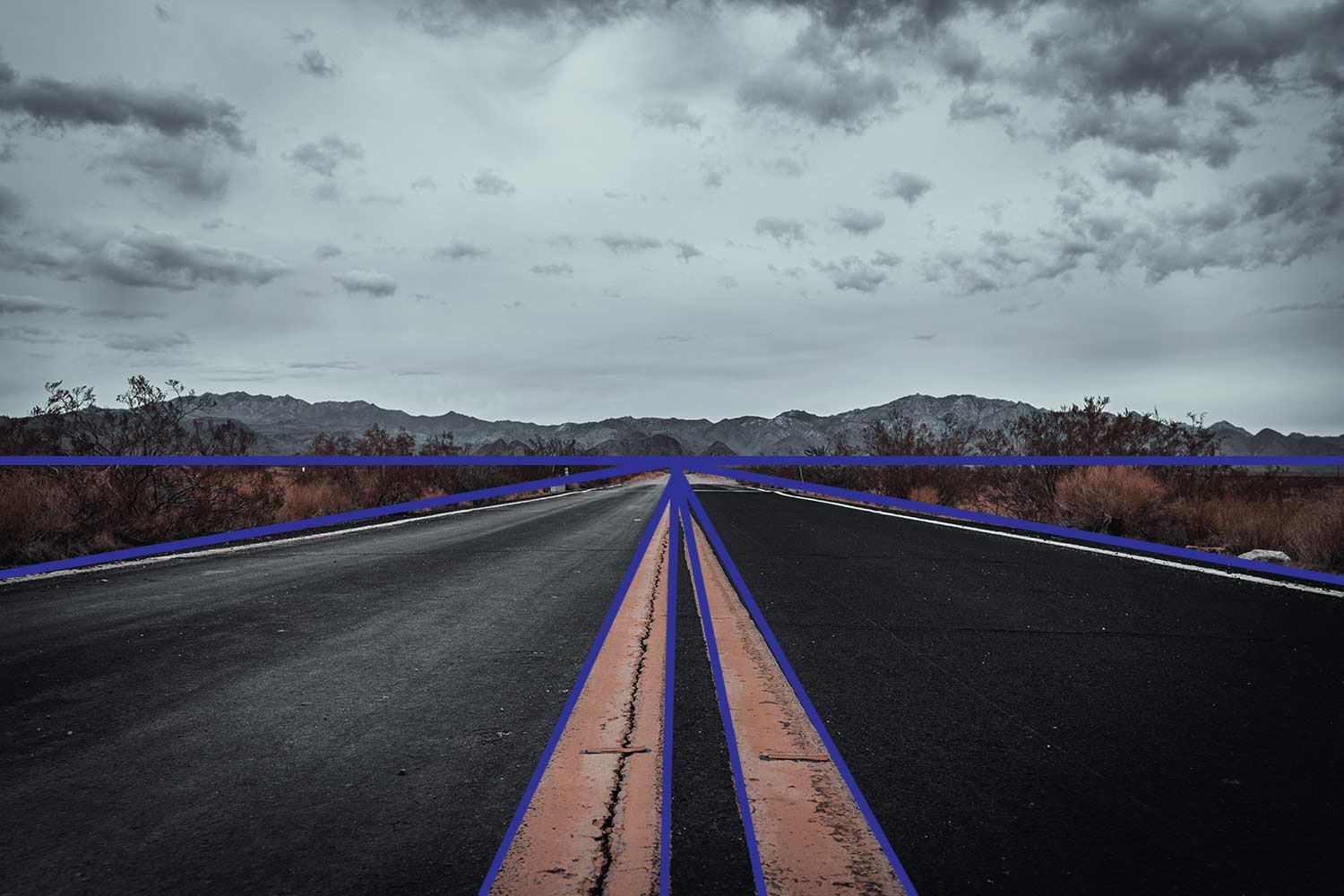
This photograph by Daniel is an excellent example of leading lines.
You can see there are in fact three sets of lines, all of different thicknesses, colours and angles, all converging on a single point.
This ties in another photographic term you should be aware of, an that is vanishing point.
Successful leading lines often use a vanishing point as well.
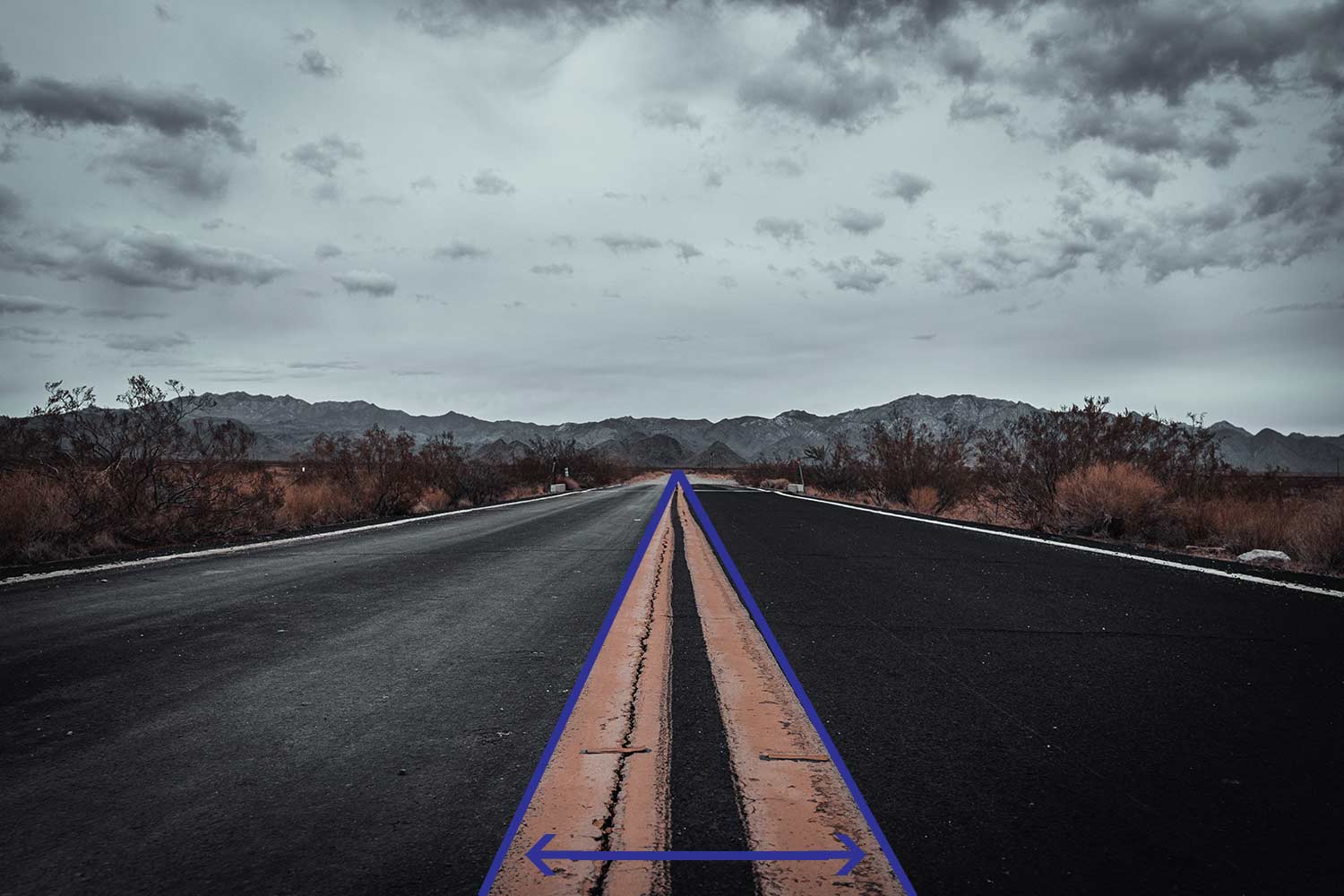
The lines start off wide at the base of the image, and become narrower as you move into the picture, seemingly into infinity.
Hence the term, vanishing point.
It creates the illusion that the lines vanish. It is the point that appears furthest away from you as the viewer.
It creates a sense of movement in the picture as it leads the eye into a specific part of the photograph.
It can be used to make the viewer look at a specific part of a picture, or it can draw you into the image and make you feel like you’re going on a journey.
This is just touching on the power of composition. The simple placement of lines can conjure all of the emotions associated with going on a journey.
So I just use lines in the picture and it will look good?
No.
Let’s look at examples where it doesn’t quite work.


Are they as effective as the image we looked at previously?
What do you think?
Here’s how I see them.
The first picture has a definite downward line that leads the eye from right to left and slopes out of the picture. This isn’t a successful composition because firstly, the eye follows the road, then the trees in the middle block the line the eye is following and disrupt the flow as they become a focal point. The eye gets to the trees an then has to stop. Then, the ‘flick’ in the road leads the eye to the left, which then joins the horizon line and leads the eye out of the left hand side of the image. Successful compositions keep the eye moving around the frame. Here the eye is led in and then out.
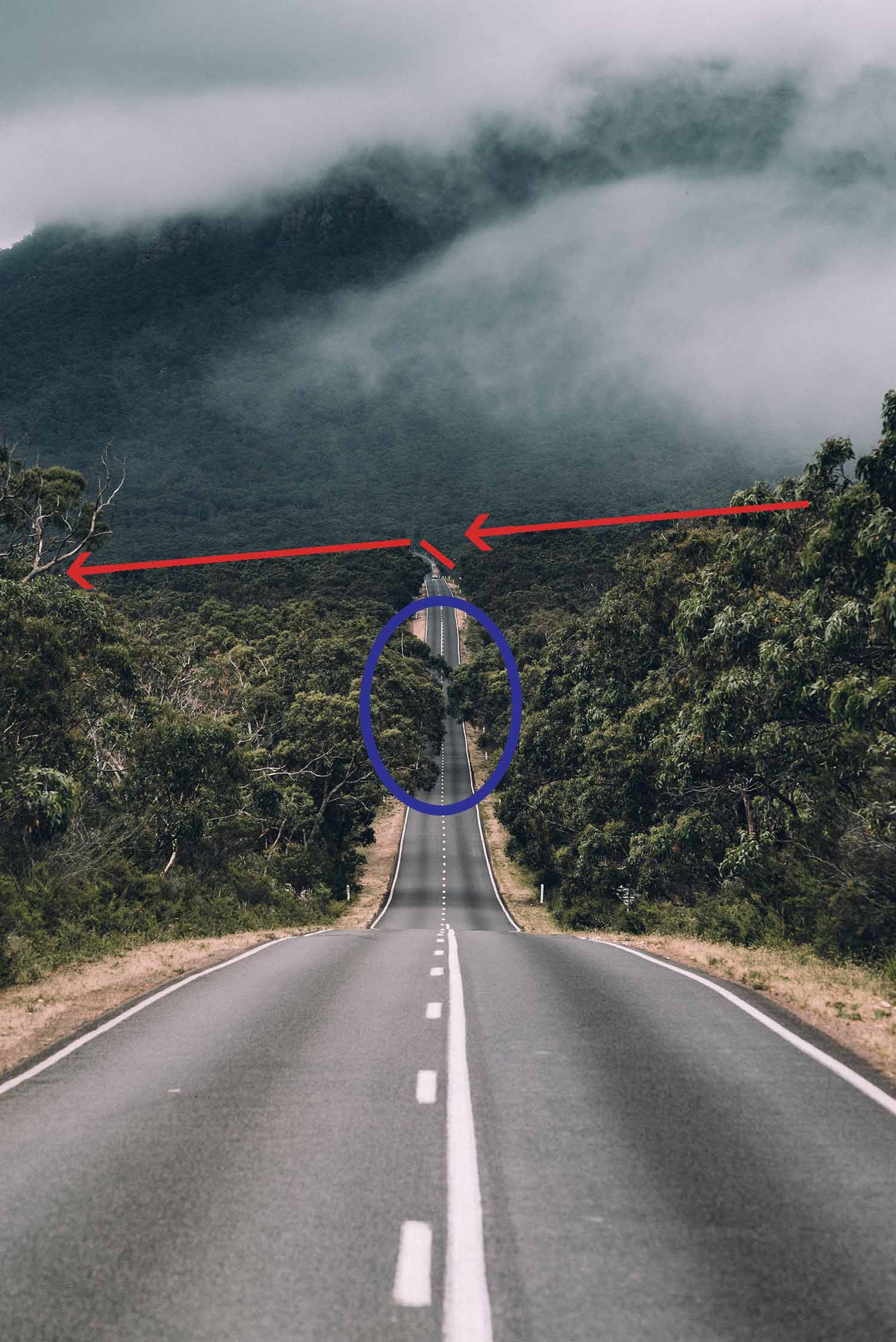
In the second image, we can see what happens when the leading line is prematurely broken.
In some instances, deliberately breaking the line can work as the eye will continue to follow the imaginary line and find it’s way to the point of interest. However in this example, the line is broken too early and the eye gets lost. I find myself then drawn to the anomaly in the image which is the pole in the centre of the frame.
It’s not a case of simply using lines. You have to take into consideration all the elements of the picture. As in this example, it would have been easy to see the train tracks and say ‘aha, i know straight lines work!’, but as you can see, the black expanse takes up a huge portion of the image and the eye has nowhere to go, nothing to focus on and the resulting image doesn’t work.

Do leading lines always have to be straight?
Good question, I think this comes down to semantics rather than exact, definite answer.
Speaking for myself, I would say no, they don’t always have to be straight.
A leading line is simply a line in the frame that deliberately leads the eye, this can happen with straight lines or curved lines.
Take Starry Night by Van Gogh for example.

This technique is called Arabesque, where a swirly pattern is used to create momentum across the image. In this case it leads the eye from left to right.
Is this a leading line? I’d say technically you would call it a ‘path’, but equally I think the two can be interchangeable.
Leading lines ideas
Once you switch on to leading lines, you’ll start to see them everywhere. Start with bold lines and then work your way to more subtle uses.
Think road markings that lead off into the distance. Fences or walls that line the street. Maybe a row of trees in your local park?
DON’T USE TRAIN TRACKS!!!!
There are too many tragic stories online regarding photographers and train tracks. Just don’t bother, there is plenty to play with without risking your life.
For those of you living in built up areas, I’d start with the buildings around you. As soon as you look up you’ll realise that the lines of the buildings naturally converge. This gives you a really easy subject to play with, and if you live in a city, potentially endless inspiration.
If you live in a more rural setting, then paths, trees, picket fences, brick walls etc. will be the best things to start with.
Here are some inspiring shots to get you fired up!

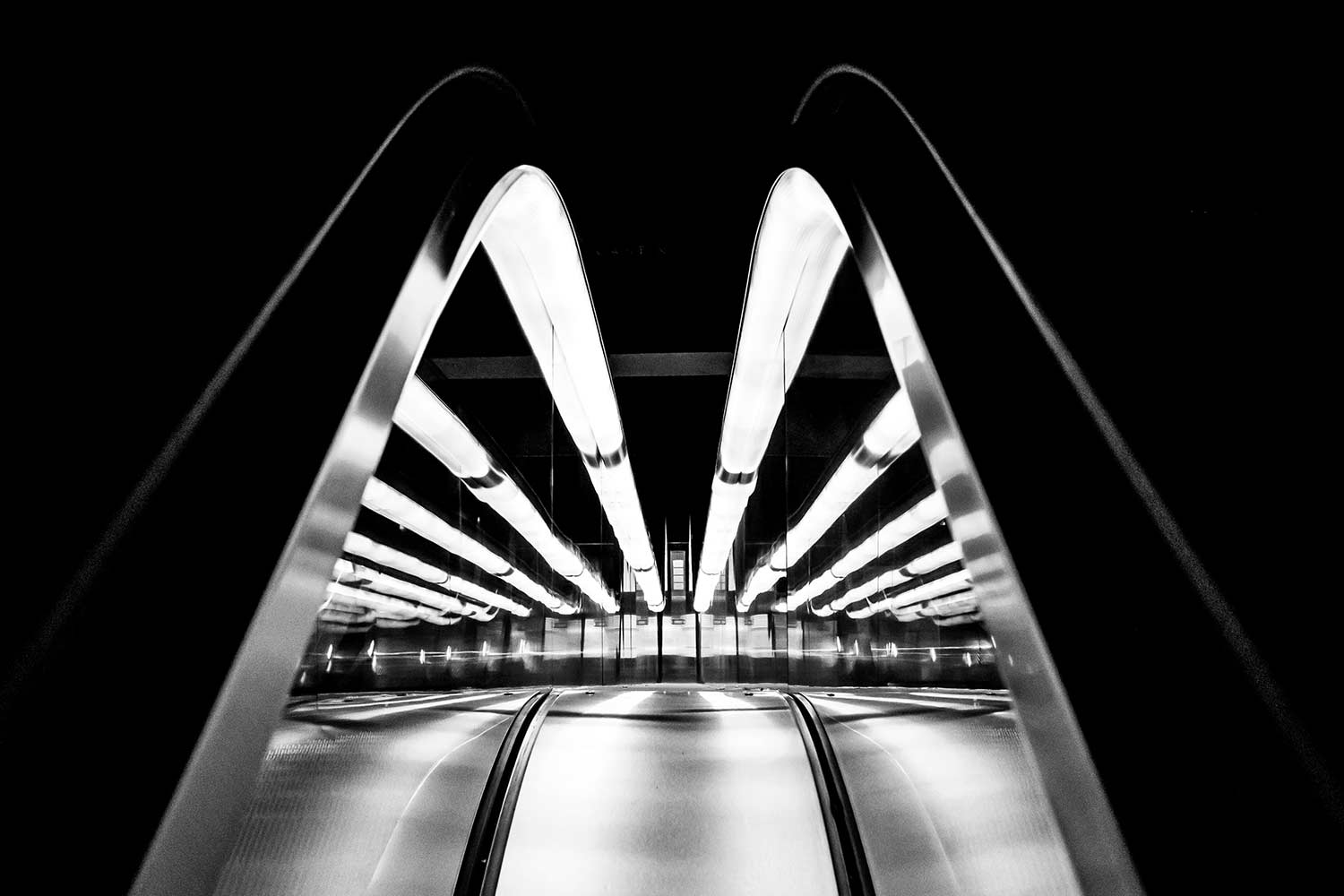
Leading lines in nature
Whilst rows of trees may be an obvious use of leading lines in nature, don’t forget the macro!
Your exploration of leading lines shouldn’t be restricted to the large and the bold, remember there is magic to be found amongst the small and the delicate.
If you take the lens off of your camera and spin it round, you can create a macro lens in an instant to explore the world of close ups. I illustrate how to make a macro lens in my article on best camera hacks, it’s number 4 on the list.


How to spot leading lines
Start by simply examining the scene through the viewfinder. Don’t even think about the picture just yet, the camera lens will compress your perspective and make leading lines easier to spot.
Another easy technique is to find something that is dead straight and stand either right next to, or on top of it.
If it’s a railing or fence, get your face right next to it, it will change your perspective and you’ll be able to appreciate how the railing gets smaller the further away it is from you. Then experiment with placing something of interest at the point where the railing finishes and see if the eye is drawn to it.
Different types of leading lines
There are several different types of leading lines, each one having an effect on the overall ‘feel’ of your image.
Horizontal lines in photographs often create balance and harmony and with it a feeling of tranquillity. They do not force the eye in any particular direction and instead allow the viewer to focus on other elements of the picture, perhaps colour or shape.
Take this image for example. With no sense of direction in the image, the eye is free to move across the image.

If you compare that with this picture for example, which uses diagonal lines, there is absolutely no doubt which direction the eye is being forced to move in.
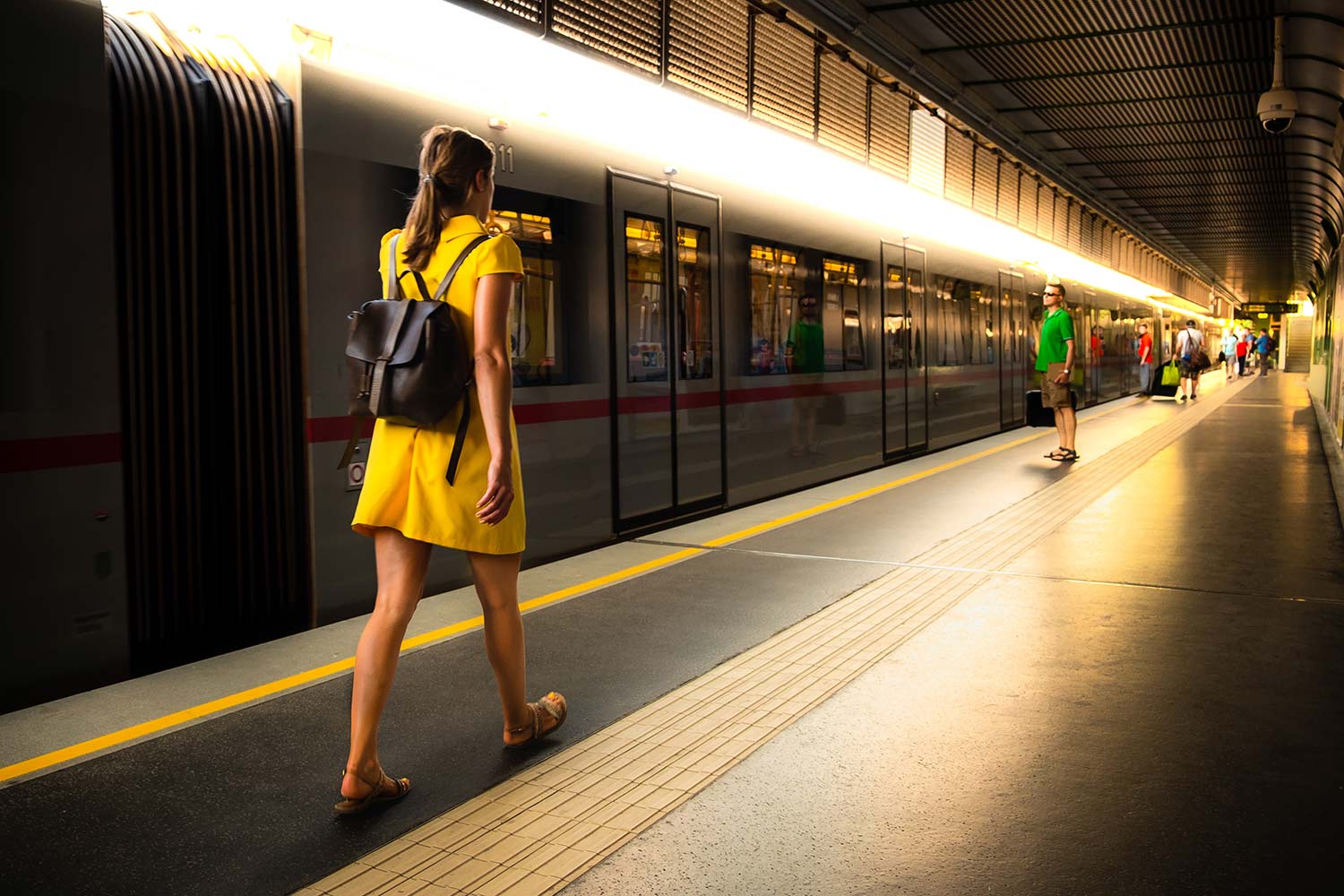
The leading lines are everywhere in this picture and they are so strong, they literally force the eye to the right hand side of the picture.
Everything from the floor to the ceiling and even the train itself creates a leading line towards the right hand side of the picture.
The movement of the person in the foreground adds to this further by creating what is called Angular Momentum. Her direction and sense of movement helps move the eye into the right side of the frame. She achieves this by moving into the negative space. It’s another compositional tool that can help you create a sense of narrative, she may be going on a journey, stepping into her future etc. It’s another thing for you to play with!
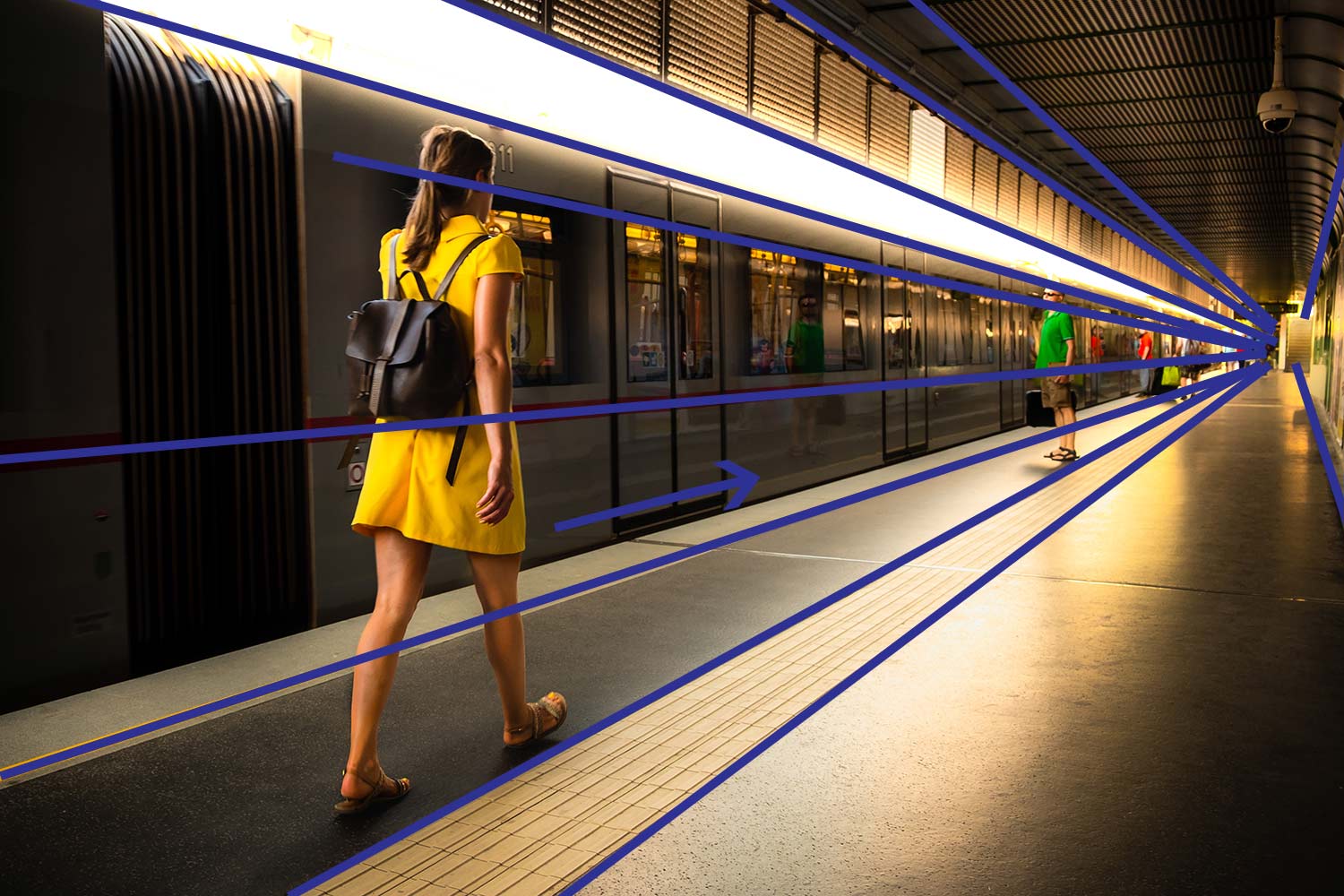
Vertical leading lines are employed to create a sense of power or dominance. This typically comes about because it creates a sense of being ‘towered over’ as the viewer, when you look up at someone bigger than you, it can make you feel small. You’ll see this technique used in films and television where the audience is supposed to acknowledge quickly that one thing is inferior to another.
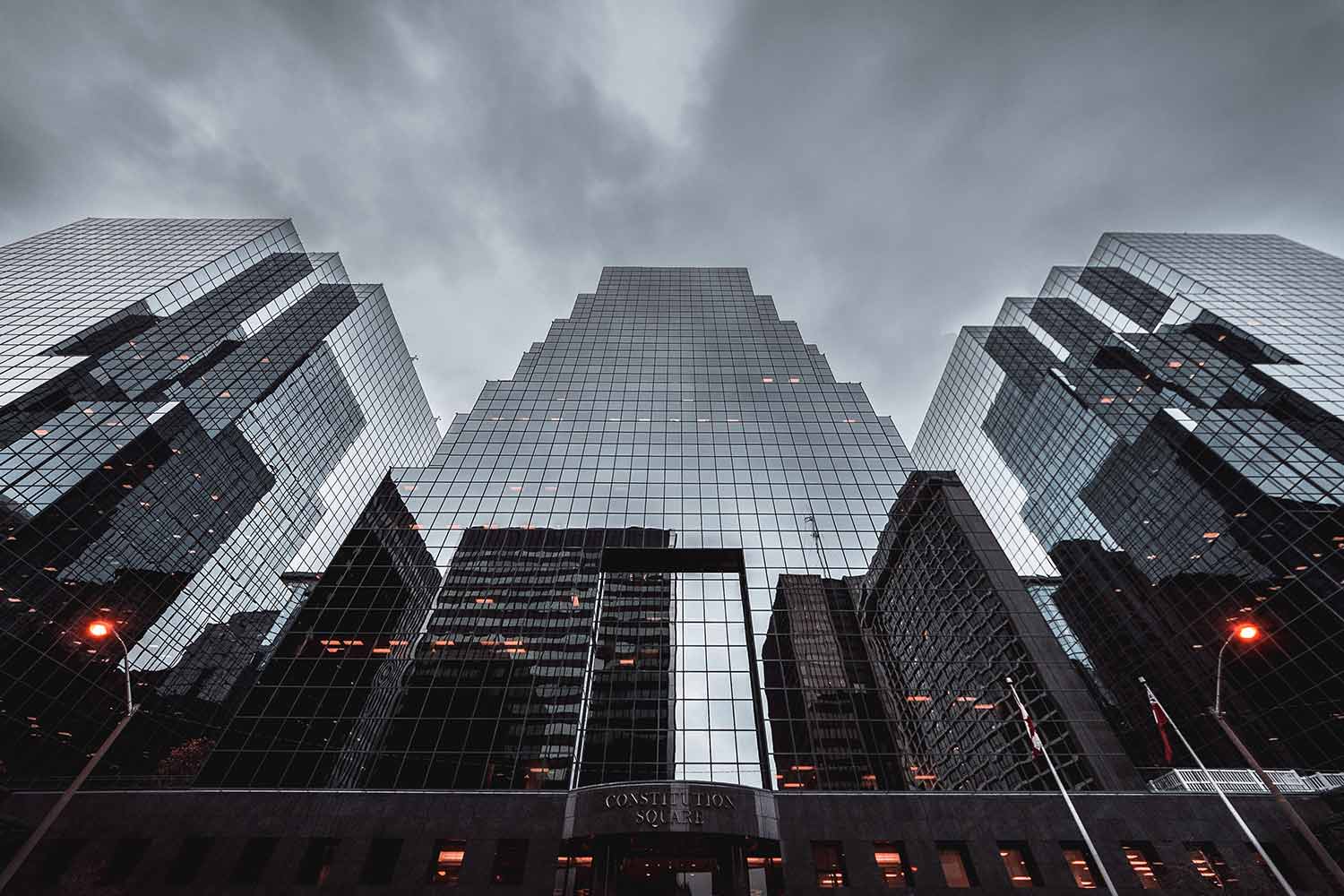
Staring at this image makes the viewer feel small. This technique can be used to convey that it is an official building, government perhaps, or a big business with lots of money. A symbol to convey power and strength. Another example of how the angle of the camera can carry so much emotive weight.
Soft leading lines
Following on from earlier – do leading lines need to be straight?
No, they can be soft. The effect being that they gently lead the eye into the image. If the curve is gentle, then the eye tracks the line easily, if it is jagged however, you run the risk of creating a feeling of haste and anxiety in the image as the eye darts from one side to the other. If you want to create a feeling of calmness, use a soft curve.

This is a good opportunity to introduce the effect of light on a leading line. It’s a great example of how composition is quite complex and you will have to understand and eventually master the entire subject. I say this because composition is not a ‘one and done’ tool, multiple elements and multiple rules have to be considered at the same time in order to produce the best images.
Take the landscape image we just used for example.
I find that because the foreground is so bright, the eye is actually drawn to the bottom of the frame and not to the top.
See if you agree, I’ve put them side by side, the one on the right with a dark gradient filter placed over the bottom.

Implied Leading Lines
Something that is very cool to play with when it comes to composition, is the implied.
The human eye and brain, whilst extraordinary in their own ways, can quite easily be tricked. The brain has a tremendous capacity to assume and detect pattern.
We can lean into this and play with it, especially when it comes to composition and leading lines.

Take this image for example, the lines are tracking horizontally, yet the eye is still drawn into the image.
Light is doing the heavy lifting here, because the eye is typically drawn to the brightest part of an image, the gradual move from dark foreground to light background leads the eye into the frame, without using any lines in that direction.
This landscape photograph below is another great example.
There are no hard lines, yet the eye is drawn from the bottom left into the picture.
The rocks create an implied line that the eye easily follows.
I would argue that the large cluster of rocks on the left of the frame unbalances the composition by drawing the eye in that direction and not allowing the eye to flow across the rest of the picture. It’s too big and anchors the eye in one spot.

The reverse lighting trick shot leading lines!
You know how I always bang on about the eye always being drawn to the brightest part of the image?
Well something amazing happens when you have a sunburst.
While the statement is originally true – the eye does jump to the sun – it miraculously then follows the light rays back out again and into the picture, where you end up examining where the light is falling.
My eyes end up on the grass, how about you?

Create your own leading lines!
If in doubt, create your own. Using a slow shutter speed the headlights and taillights of cars can be used to create leading lines.
Start off by using a torch and running up the garden. Have fun with it.

Keep studying, keep practicing
There’s no substitute for hard graft. Get out there, take some pictures, sit down and analyse them.
It’s the only way you’ll really get your head around where you need to improve.
#photographyproject on Instagram so I can see what you’ve been up to. Feel free to message me directly if you need help.
There are many ways to take advantage of this useful compositional tool. Why not try some of the following for yourself?
Use diagonal hard lines to create angular momentum, and a sense of direction from one side of the image to the other.
Use soft leading lines to create a sense of harmony in a landscape.
Stand at the foot of a building and look up. Use the hard leading lines to make the building feel imposing.
Create a vanishing point by finding a leading line that moves towards the horizon and disappears.
Find an implied leading line where the line is broken, but the eye continues along the path to an object.
Experiment with different heights, different angles, different lenses, different depths of field and different focal points. There is so much to experiment with and explore, I can’t wait to see what you do.
